Hover Flight Improvement of a Quadrotor Unmanned Aerial Vehicle Using PID Controllers with an Integral Effect Based on the Riemann–Liouville Fractional-Order Operator: A Deterministic Approach
Abstract
:1. Introduction
2. Problem Statement
3. Mathematical Modeling of an Unmanned Aerial Vehicle (UAV)
3.1. UAV Kinematics
3.2. UAV State-Space Model
3.3. Linearization of the UAV Mathematical Model
4. Main Results
4.1. Classical Order Control System Design
4.2. Fractional-Order Control System Design
5. Validation and Discussion of the Results
5.1. Closed-Loop Response Comparison for UAV Hover Flight Using COCSH vs. FOCSH
5.2. Discussion
6. Conclusions
Author Contributions
Funding
Data Availability Statement
Conflicts of Interest
References
- Frigioescu, T.-F.; Condruz, M.R.; Badea, T.A.; Paraschiv, A. A Preliminary Study on the Development of a New UAV Concept and the Associated Flight Method. Drones 2023, 7, 166. [Google Scholar] [CrossRef]
- Telli, K.; Kraa, O.; Himeur, Y.; Ouamane, A.; Boumehraz, M.; Atalla, S.; Mansoor, W. A Comprehensive Review of Recent Research Trends on Unmanned Aerial Vehicles (UAVs). Systems 2023, 11, 400. [Google Scholar] [CrossRef]
- Arafat, M.Y.; Alam, M.M.; Moh, S. Vision-Based Navigation Techniques for Unmanned Aerial Vehicles: Review and Challenges. Drones 2023, 7, 89. [Google Scholar] [CrossRef]
- Saunders, J.; Saeedi, S.; Li, W. Autonomous aerial robotics for package delivery: A technical review. J. Field Robot. 2023, 41, 1. [Google Scholar] [CrossRef]
- Delavarpour, N.; Koparan, C.; Nowatzki, J.; Bajwa, S.; Sun, X. A Technical Study on UAV Characteristics for Precision Agriculture Applications and Associated Practical Challenges. Remote Sens. 2021, 13, 1204. [Google Scholar] [CrossRef]
- Liang, H.; Lee, S.-C.; Bae, W.; Kim, J.; Seo, S. Towards UAVs in Construction: Advancements, Challenges, and Future Directions for Monitoring and Inspection. Drones 2023, 7, 202. [Google Scholar] [CrossRef]
- Balestrieri, E.; Daponte, P.; De Vito, L.; Picariello, F.; Tudosa, I. Sensors and Measurements for UAV Safety: An Overview. Sensors 2021, 21, 8253. [Google Scholar] [CrossRef]
- Hoffmann, G.; Huang, H.; Waslander, S.; Tomlin, C. Quadrotor helicopter flight dynamics and control: Theory and experiment. In Proceedings of the AIAA Guidance, Navigation and Control Conference and Exhibit, Hilton Head, SC, USA, 20–23 August 2007. [Google Scholar] [CrossRef]
- Pan, F.; Liu, L.; Xue, D. Optimal PID controller design with Kalman filter for Qball-X4 quad-rotor unmanned aerial vehicle. Trans. Inst. Meas. Control. 2017, 39, 1785–1797. [Google Scholar] [CrossRef]
- Abdulridha, N.M.; Mary, A.H.; Jasim, H.H. Optimized PID, FOPID and PIDD2 for Controlling UAV Based on SSA. Am. Sci. Res. J. Eng. Technol. Sci. 2023, 92, 77–90. [Google Scholar]
- Priyambodo, T.K.; Dhewa, O.A.; Susanto, T. Model of Linear Quadratic Regulator (LQR) Control System in Waypoint Flight Mission of Flying Wing UAV. J. Telecommun. Electron. Comput. Eng. 2020, 12, 43–49. [Google Scholar]
- Dhewa, O.; Dharmawan, A.; Priyambodo, T.K. Model of Linear Quadratic Regulator (LQR) Control Method in Hovering State of Quadrotor. J. Telecommun. Electron. Comput. Eng. 2017, 9, 135–143. [Google Scholar]
- Omar, M.F.; Ghazali, R.; Saadon, I.M.; Aripin, M.K.; Sam, Y.M.; Soon, C.C. Optimal Control for Sport Utility Vehicle System Using Linear Quadratic Integral Control Approach. J. Telecommun. Electron. Comput. Eng. 2018, 10, 143–149. [Google Scholar]
- Saccani, D.; Cecchin, L.; Fagiano, L. Multitrajectory Model Predictive Control for Safe UAV Navigation in an Unknown Environment. IEEE Trans. Control. Syst. Technol. 2023, 31, 1982–1997. [Google Scholar] [CrossRef]
- Singh, B.K.; Kumar, A. Model predictive control using LPV approach for trajectory tracking of quadrotor UAV with external disturbances. Aircr. Eng. Aerosp. Technol. 2023, 95, 607–618. [Google Scholar] [CrossRef]
- Bouadi, H.; Bouchoucha, M.; Tadjine, M. Sliding mode control based on backstepping approach for an UAV type-quadrotor. Int. J. Mech. Mechatron. Eng. 2007, 1, 39–44. [Google Scholar]
- Jiang, X.; Su, C.; Xu, Y.; Liu, K.; Shi, H.; Li, P. An adaptive backstepping sliding mode method for flight attitude of quadrotor UAVs. J. Cent. South Univ. 2018, 25, 616–631. [Google Scholar] [CrossRef]
- Madani, T.; Benallegue, A. Backstepping control for a quadrotor helicopter. In Proceedings of the 2006 IEEE/RSJ International Conference on Intelligent Robots and Systems, Beijing, China, 9–13 October 2006. [Google Scholar] [CrossRef]
- Richards, A.; How, J. Aircraft trajectory planning with collision avoidance using mixed integer linear programming. In Proceedings of the 2002 American Control Conference (IEEE Cat. No. CH37301), Anchorage, AK, USA, 8–10 May 2002. [Google Scholar] [CrossRef]
- Wang, C.; Wang, J.; Wang, J.; Zhang, X. Deep-reinforcement-learning-based autonomous UAV navigation with sparse rewards. IEEE Internet Things J. 2020, 7, 6180–6190. [Google Scholar] [CrossRef]
- Monje, C.; Vinagre, B.; Feliu, V.; Chen, Y. Tuning and auto-tuning of fractional order controllers for industry applications. Control. Eng. Pract. 2008, 16, 798–812. [Google Scholar] [CrossRef]
- Yoon, J.; Doh, J. Optimal PID control for hovering stabilization of quadcopter using long short term memory. Adv. Eng. Inform. 2022, 53, 101679. [Google Scholar] [CrossRef]
- Shang, B.; Liu, J.; Zhao, T.; Chen, Y. Fractional order robust visual servoing control of a quadrotor UAV with larger sampling period. In Proceedings of the International Conference on Unmanned Aircraft Systems (ICUAS), Arlington, VA, USA, 7–10 June 2016. [Google Scholar] [CrossRef]
- Delgado, G.; Valdez, J.S.; Hernández, M.Á.; Pérez, K.R.; García, P.J. Quadrotor Real-Time Simulation: A Temporary Computational Complexity-Based Approach. Mathematics 2022, 10, 2032. [Google Scholar] [CrossRef]
- Chan, Y.Y.; Kam, K.H.; Lee, C.K.M.; Li-Ta, H.; Keung, K.L. Wind dynamic and energy-efficiency path planning for unmanned aerial vehicles in the lower-level airspace and urban air mobility context. Sustain. Energy Technol. Assess. 2023, 57, 103202. [Google Scholar] [CrossRef]
- Timis, D.D.; Muresan, C.I.; Dulf, E.-H. Design and Experimental Results of an Adaptive Fractional-Order Controller for a Quadrotor. Fractal Fract. 2022, 6, 204. [Google Scholar] [CrossRef]
- Al-Dhaifallah, M.; Al-Qahtani, F.M.; Elferik, S.; Saif, A.-W.A. Quadrotor Robust Fractional-Order Sliding Mode Control in Unmanned Aerial Vehicles for Eliminating External Disturbances. Aerospace 2023, 10, 665. [Google Scholar] [CrossRef]
- Dulf, E.H.; Timis, D.; Muresan, C.I. Robust Fractional Order Controllers for Distributed Systems. Acta Polytech. Hung. 2017, 14, 163–176. [Google Scholar] [CrossRef]
- Jain, S.; Hote, Y.; Dehuri, P.; Mittal, D.; Siddhartha, V. Experimental validation of fractional order internal model controller design on buck and boost converter. Meas. Control. 2020, 54, 748–766. [Google Scholar] [CrossRef]
- Haseeb, A.; Ali, A.; Hasan, I. Fractional Order Sliding Mode Controller for Heading and Heave Control of Quadcopter. In Proceedings of the 2nd International Conference on on Engineering, Natural and Social Sciences (ICENSOS), Konya, Turkey, 4–6 April 2023. [Google Scholar]
- Sadigh, R. Optimizing PID Controller Coefficients Using Fractional Order Based on Intelligent Optimization Algorithms for Quadcopter. In Proceedings of the 6th RSI International Conference on Robotics and Mechatronics (IcRoM), Tehran, Iran, 23–25 October 2018. [Google Scholar] [CrossRef]
- Shao, K.; Liu, J.; Li, M. Fractional order PID control of quadrotor UAV based on SA-PSO algorithm. In Proceedings of the Third International Conference on Computer Science and Communication Technology (ICCSCT 2022), Beijing, China, 30–31 July 2022. [Google Scholar] [CrossRef]
- Song, J.; Hu, Y.; Su, J.; Zhao, M.; Ai, S. Fractional-Order Linear Active Disturbance Rejection Control Design and Optimization Based Improved Sparrow Search Algorithm for Quadrotor UAV with System Uncertainties and External Disturbance. Drones 2022, 6, 229. [Google Scholar] [CrossRef]
- Moness, M.; Abdelghany, M.B.; Mohammed, K.M.; Mohamed, M.; Moustafa, A.M. Surrogate Optimal Fractional Control for Constrained Operational Service of UAV Systems. Drones 2024, 8, 141. [Google Scholar] [CrossRef]
- Moreira, E.; Shiroma, P. Design of fractional PID controller in time-domain for a fixed-wing unmanned aerial vehicle. In Proceedings of the 2017 Latin American Robotics Symposium (LARS) and 2017 Brazilian Symposium on Robotics (SBR), Curitiba, Brazil, 8–11 November 2017. [Google Scholar] [CrossRef]
- Yu, Z.; Zhang, Y.; Jiang, B.; Su, C.Y.; Fu, J.; Jin, Y.; Chai, T. Fractional order PID-based adaptive fault-tolerant cooperative control of networked unmanned aerial vehicles against actuator faults and wind effects with hardware-in-the-loop experimental validation. Control. Eng. Pract. 2021, 114, 1–12. [Google Scholar] [CrossRef]
- Vahdanipour, M.; Khodabandeh, M. Adaptive fractional order sliding mode control for a quadrotor with a varying load. Aerosp. Sci. Technol. 2019, 86, 737–747. [Google Scholar] [CrossRef]
- Li, J.; Chen, P.; Chang, Z.; Zhang, G.; Guo, L.; Zhao, C. Trajectory Tracking Control of Quadrotor Based on Fractional-Order S-Plane Model. Machines 2023, 11, 672. [Google Scholar] [CrossRef]
- Okoronkwo, J.O.; Mati, A.; Yusuf, J.; Olarinoye, G.; Abubakar, A.S. Development of Fractional Order Controller for Load Frequency Control of Multi Area Interconnected Microgrid Power System. In Proceedings of the 2021 1st International Conference on Multidisciplinary Engineering and Applied Science (ICMEAS), Abuja, Nigeria, 15–16 July 2021. [Google Scholar] [CrossRef]
- Huang, Y.; Nitsche, M.; Kanso, E. Stability versus maneuverability in hovering flight. Phys. Fluids 2015, 27, 061706. [Google Scholar] [CrossRef]
- Kim, D.; Lee, Y.; Oh, S.; Park, Y.; Choi, J.; Park, D. Aerodynamic analysis and static stability analysis of Manned/unmanned distributed propulsion aircrafts using actuator methods. J. Wind. Eng. Ind. Aerodyn. 2021, 214, 104648. [Google Scholar] [CrossRef]
- Hernández-Pérez, M.A.; Delgado-Reyes, G.; Borja-Jaimes, V.; Valdez-Martínez, J.S.; Cervantes-Bobadilla, M. An Adaptation of a Sliding Mode Classical Observer to a Fractional-Order Observer for Disturbance Reconstruction of a UAV Model: A Riemann–Liouville Fractional Calculus Approach. Mathematics 2023, 11, 4876. [Google Scholar] [CrossRef]
- Cando, L.; Hernandez, M.A.; Delgado, G.; Galván, R.; Orozco, R. Design and Implementation of a Rotating Hydrodynamic System for Electrochemical Noise Measurement. ECS Trans. 2023, 110, 79–91. [Google Scholar] [CrossRef]
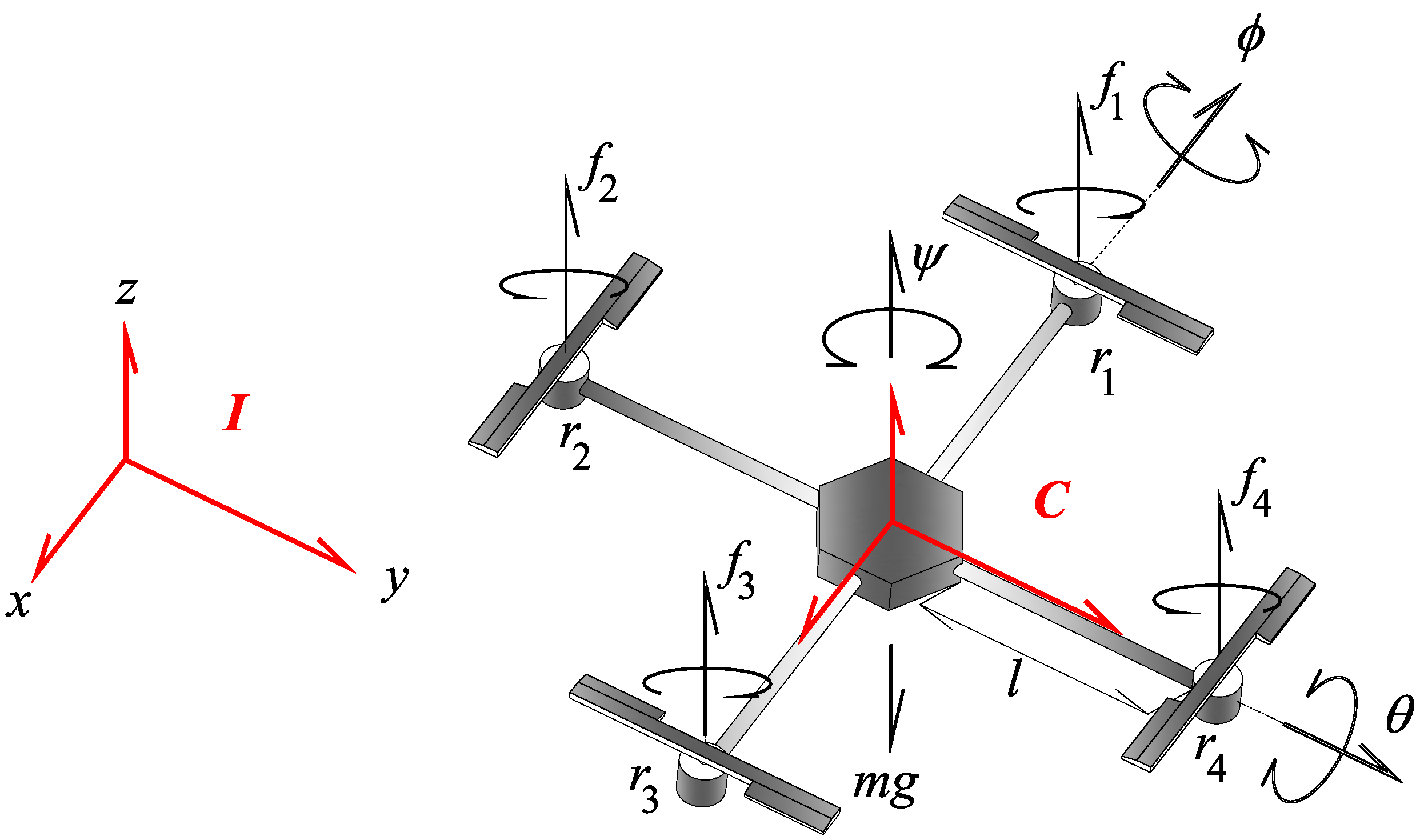
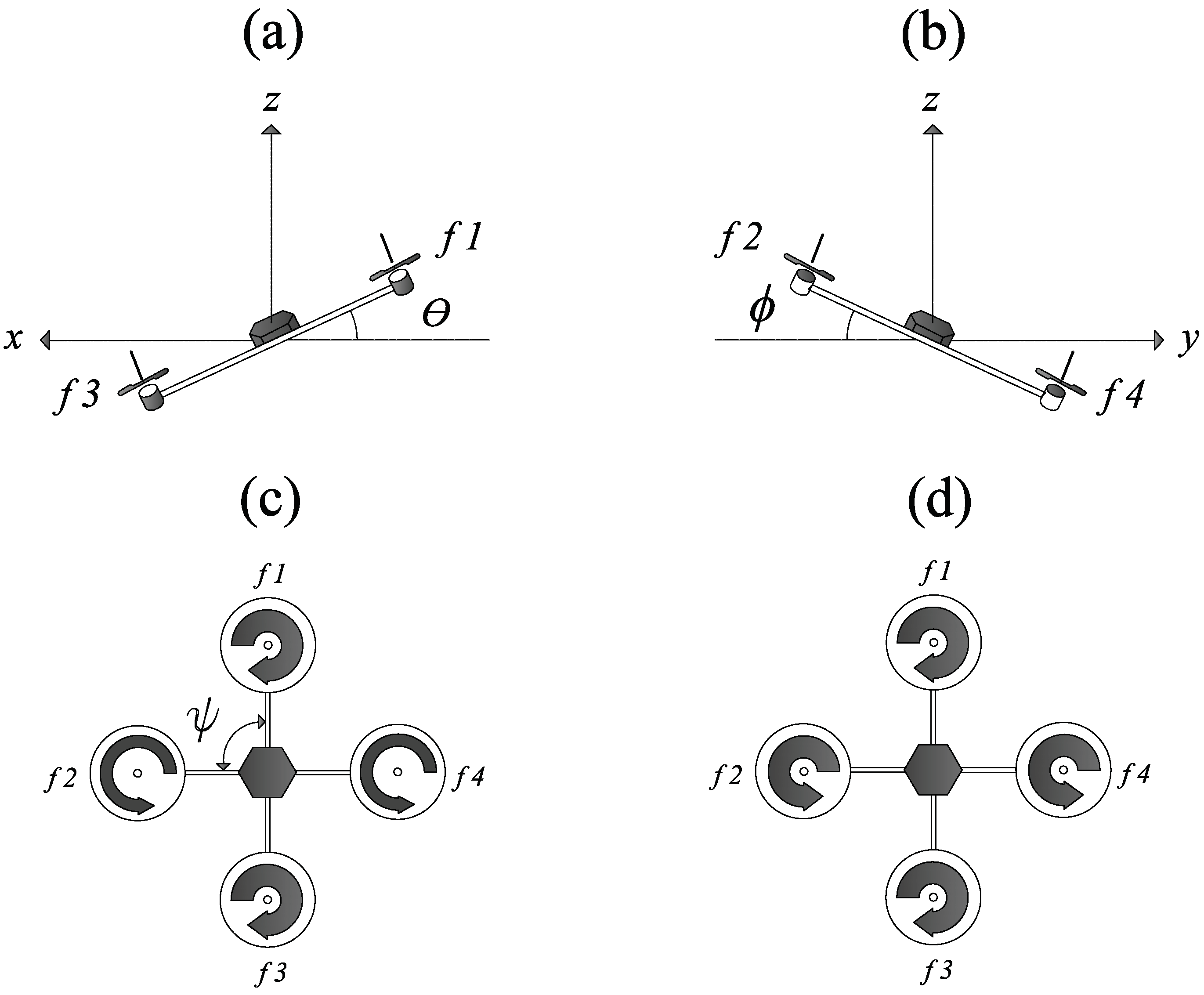

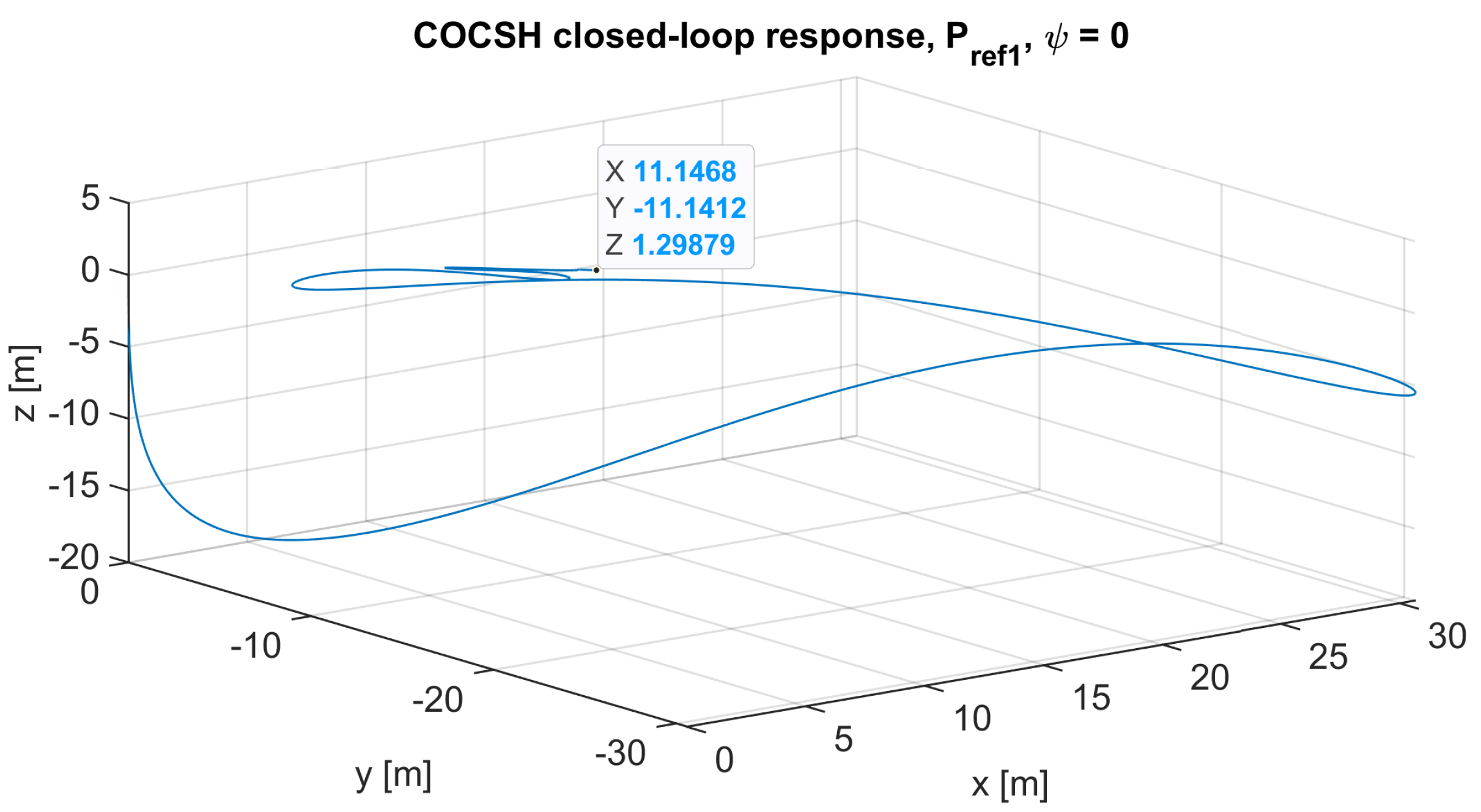
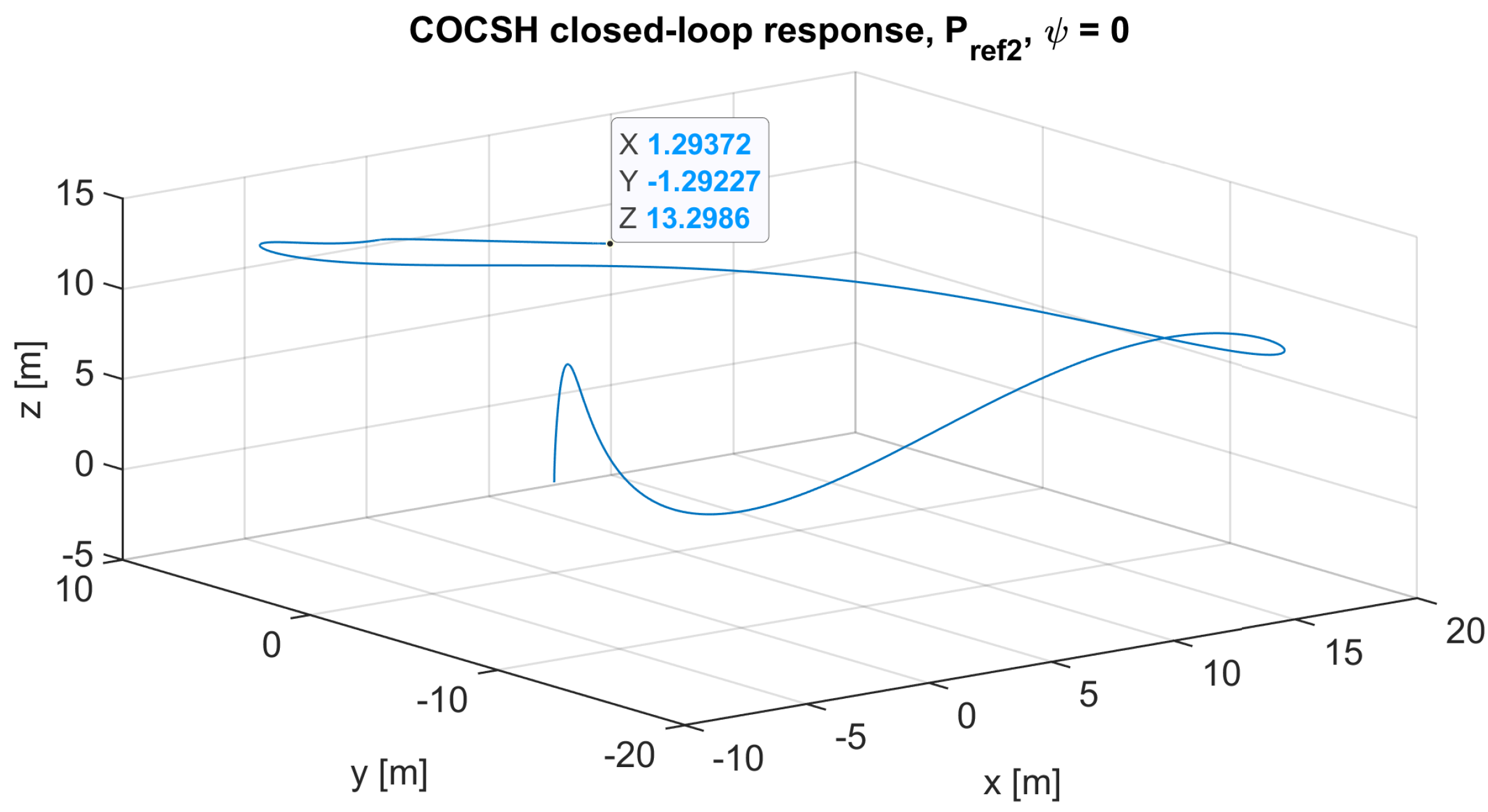
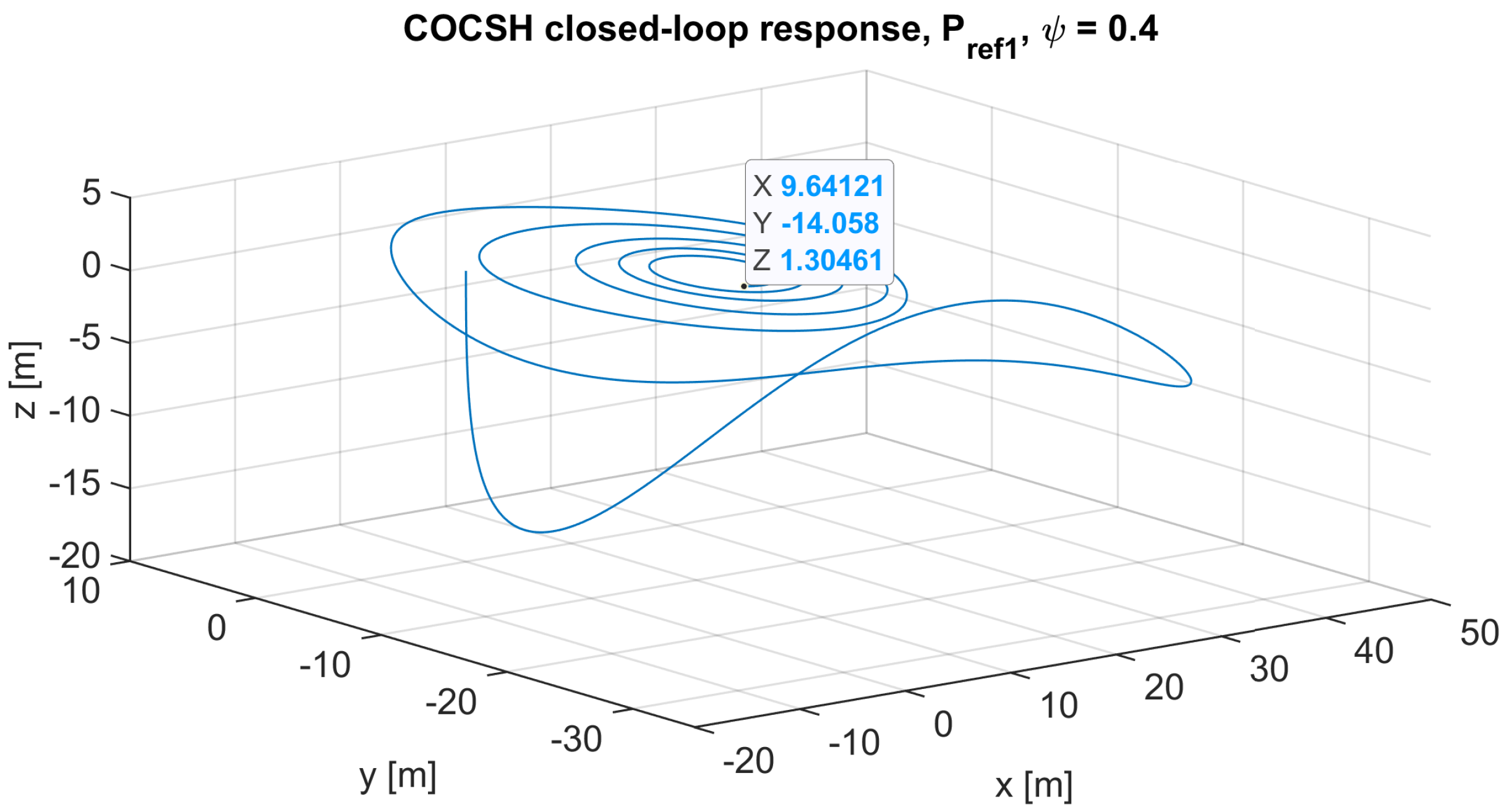
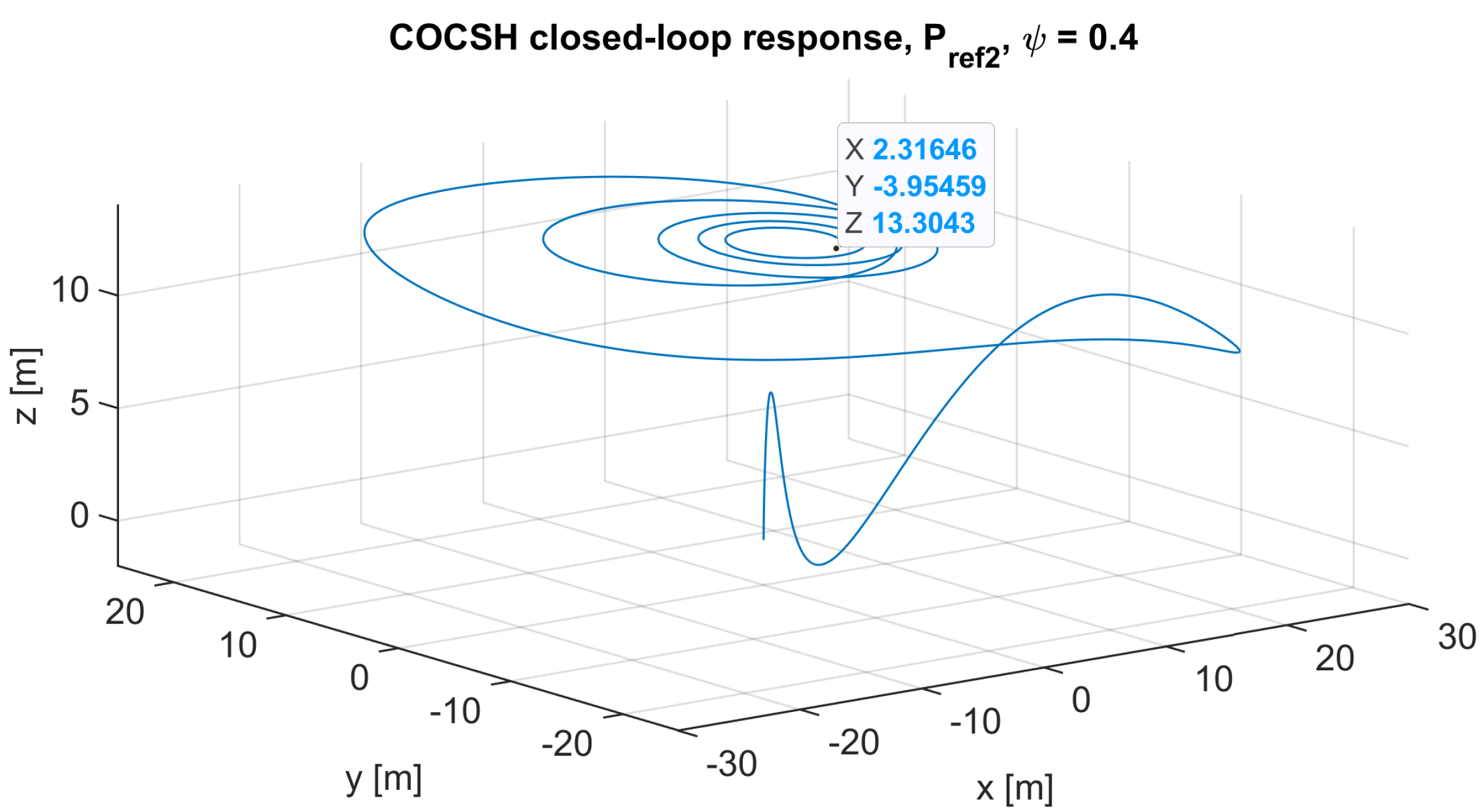




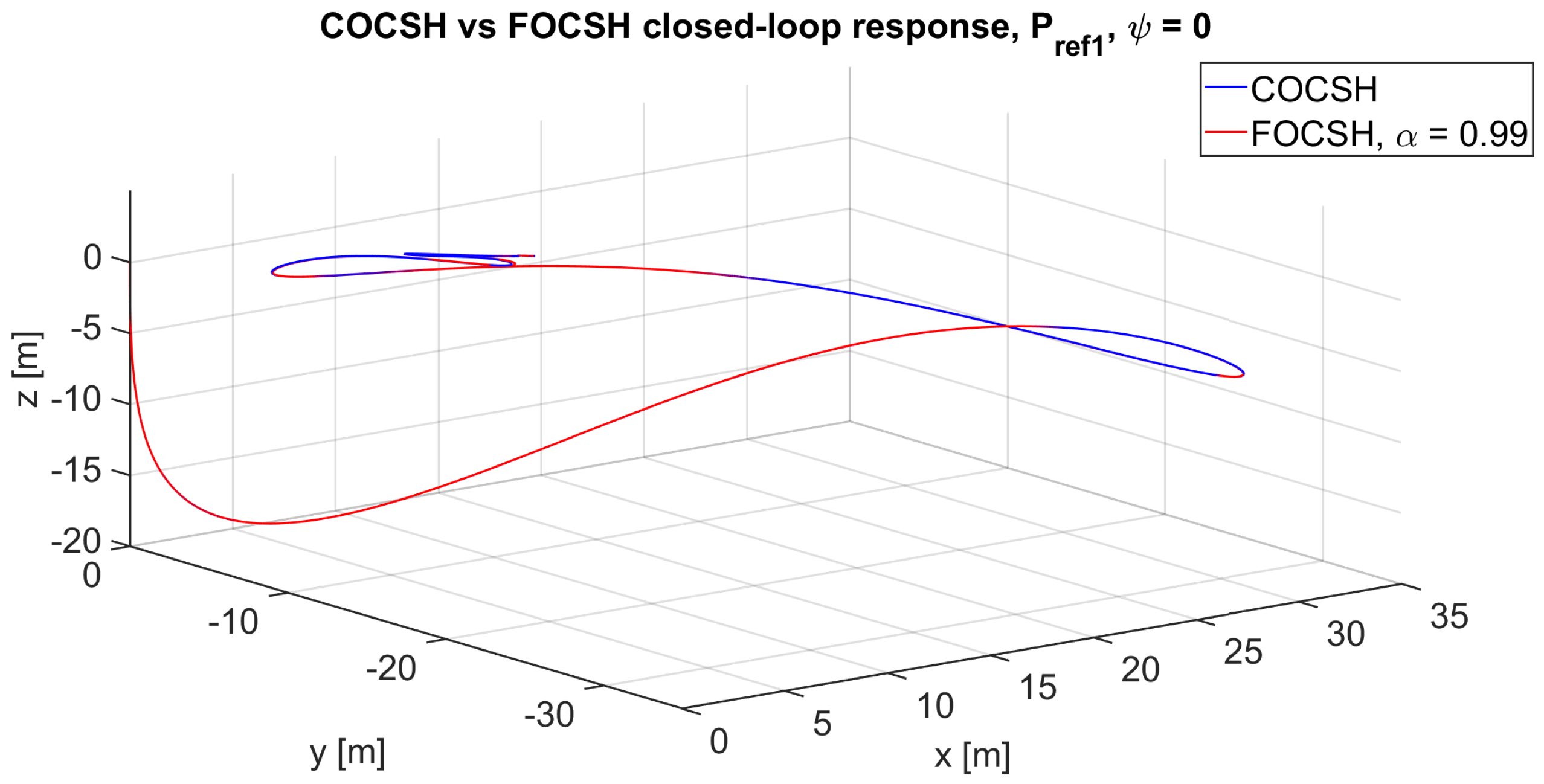
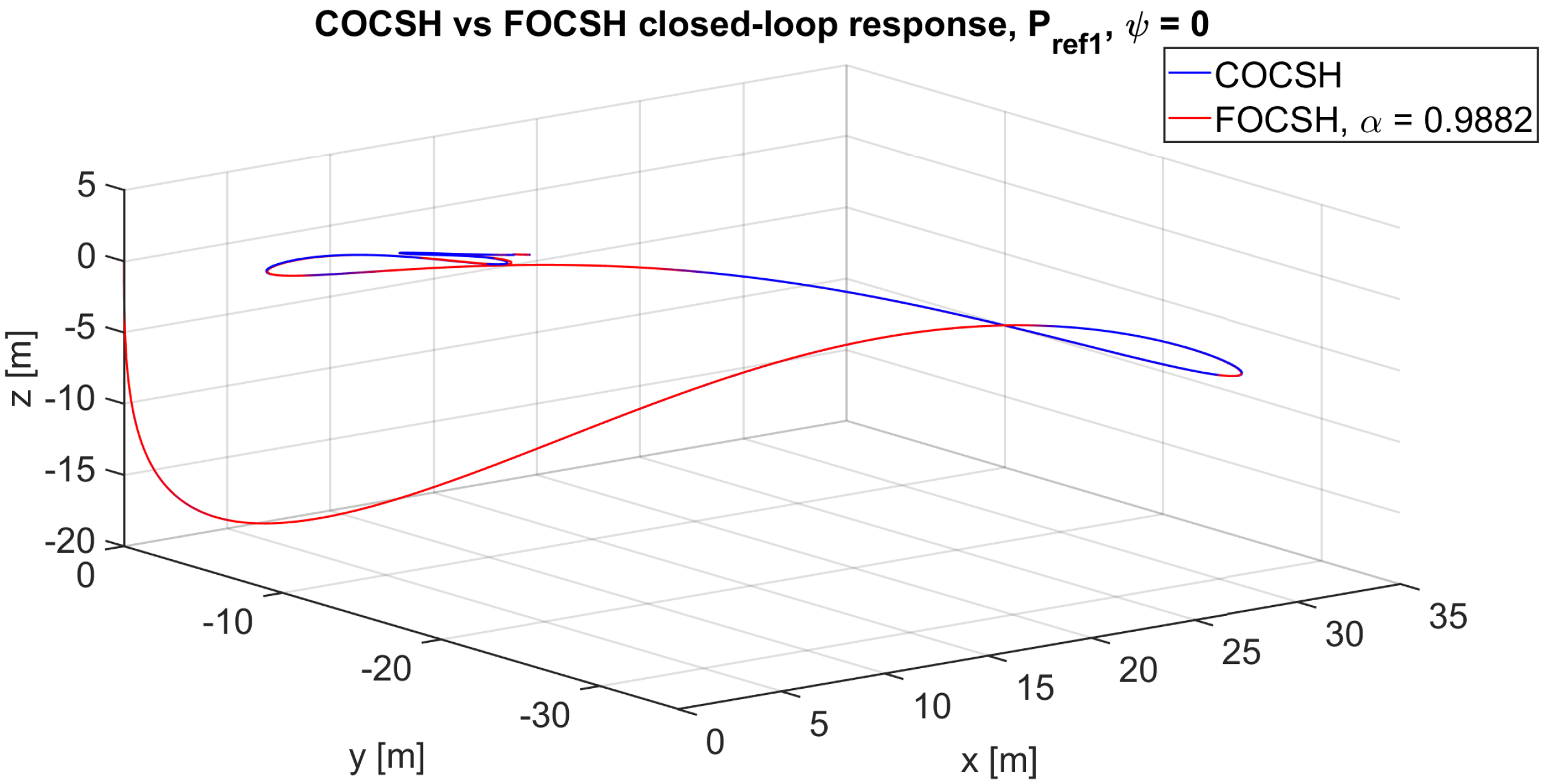

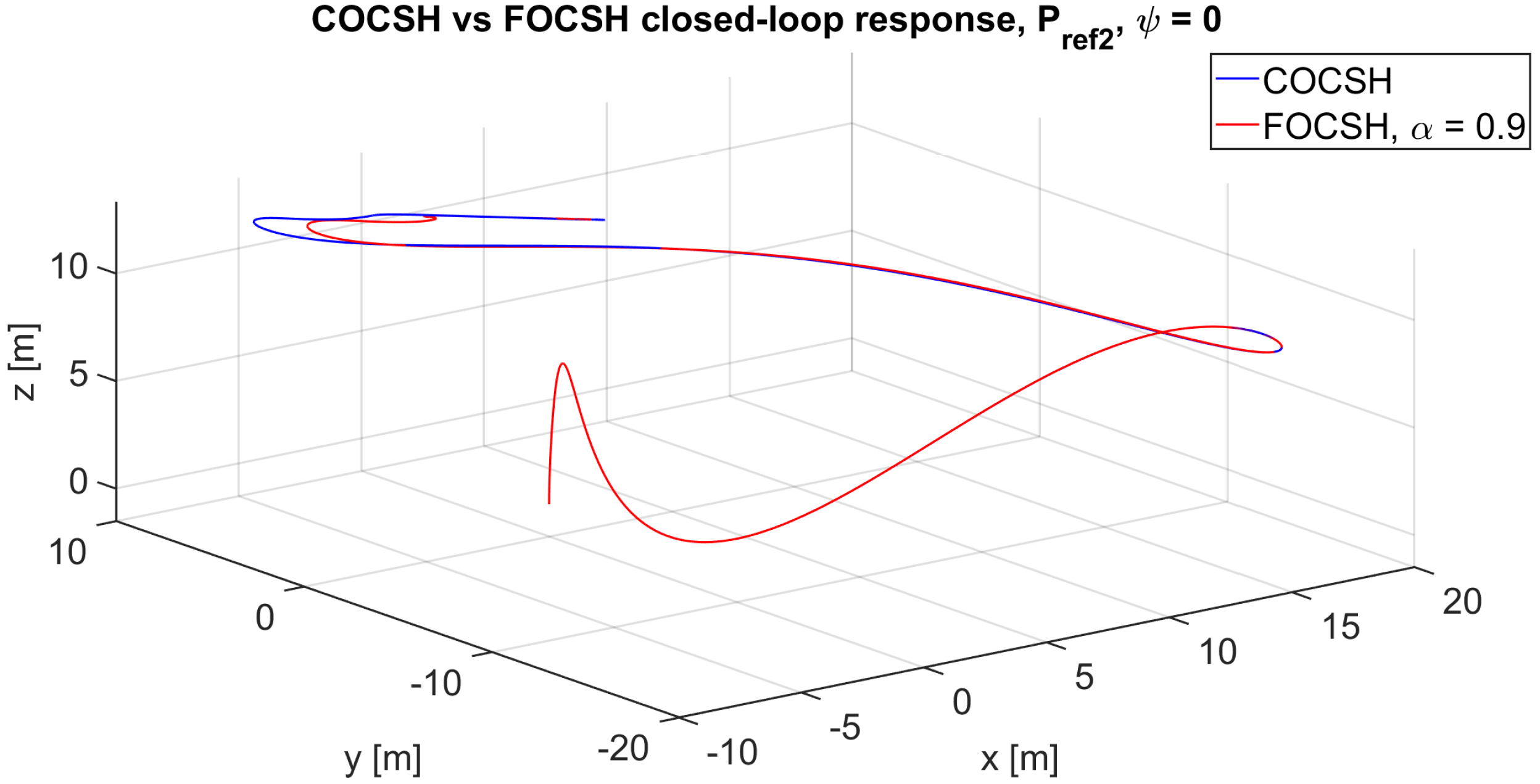

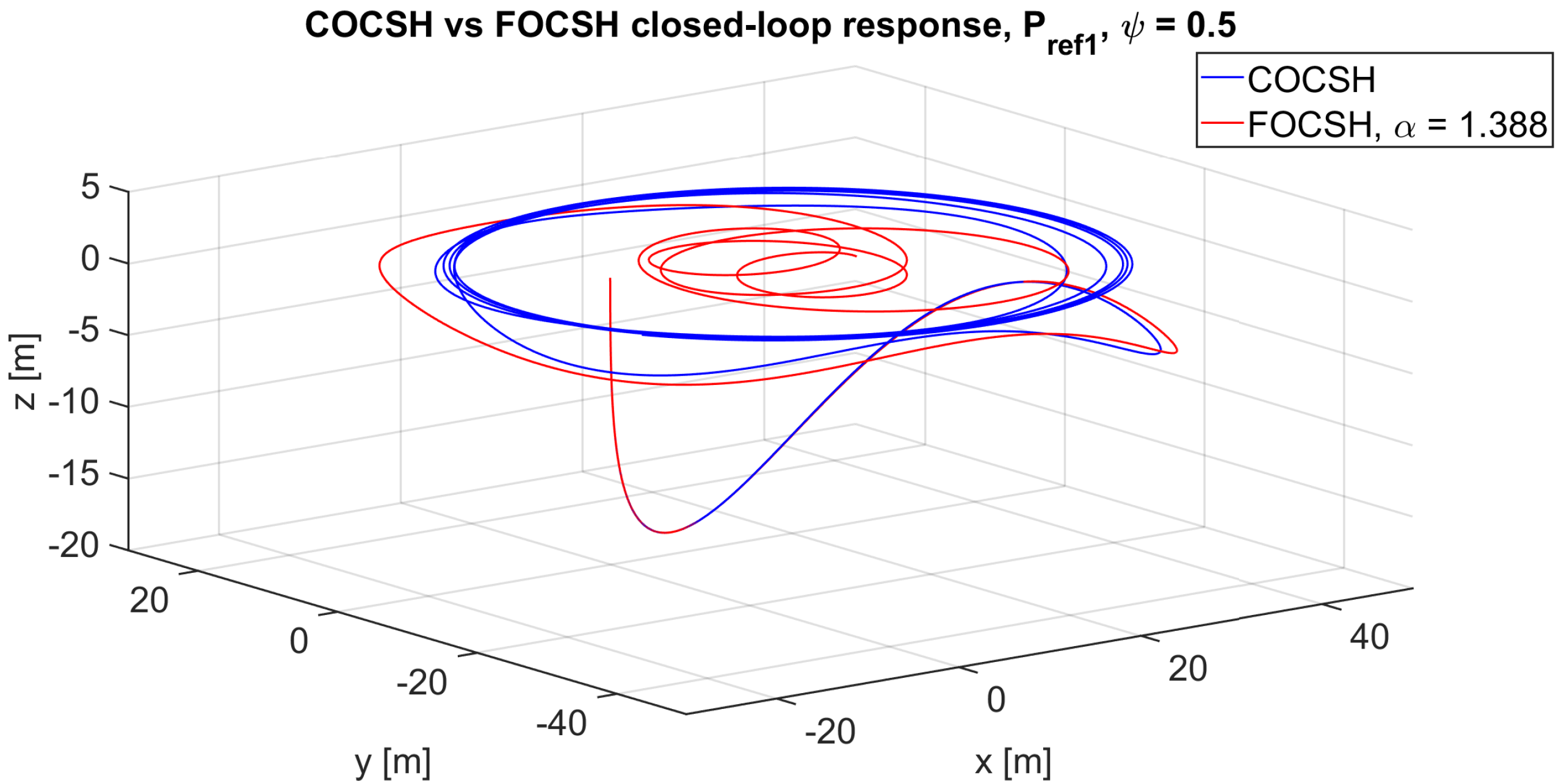
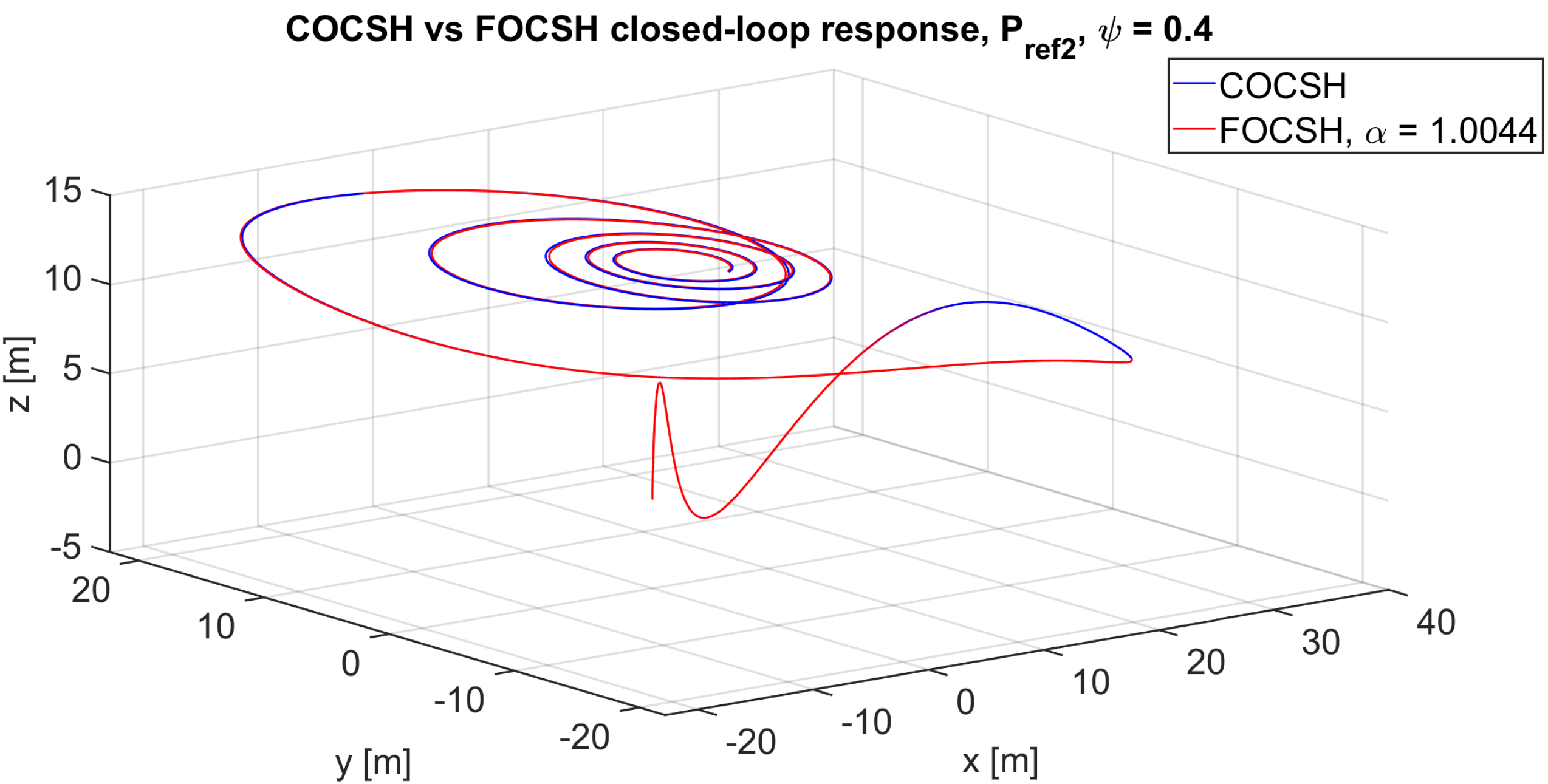




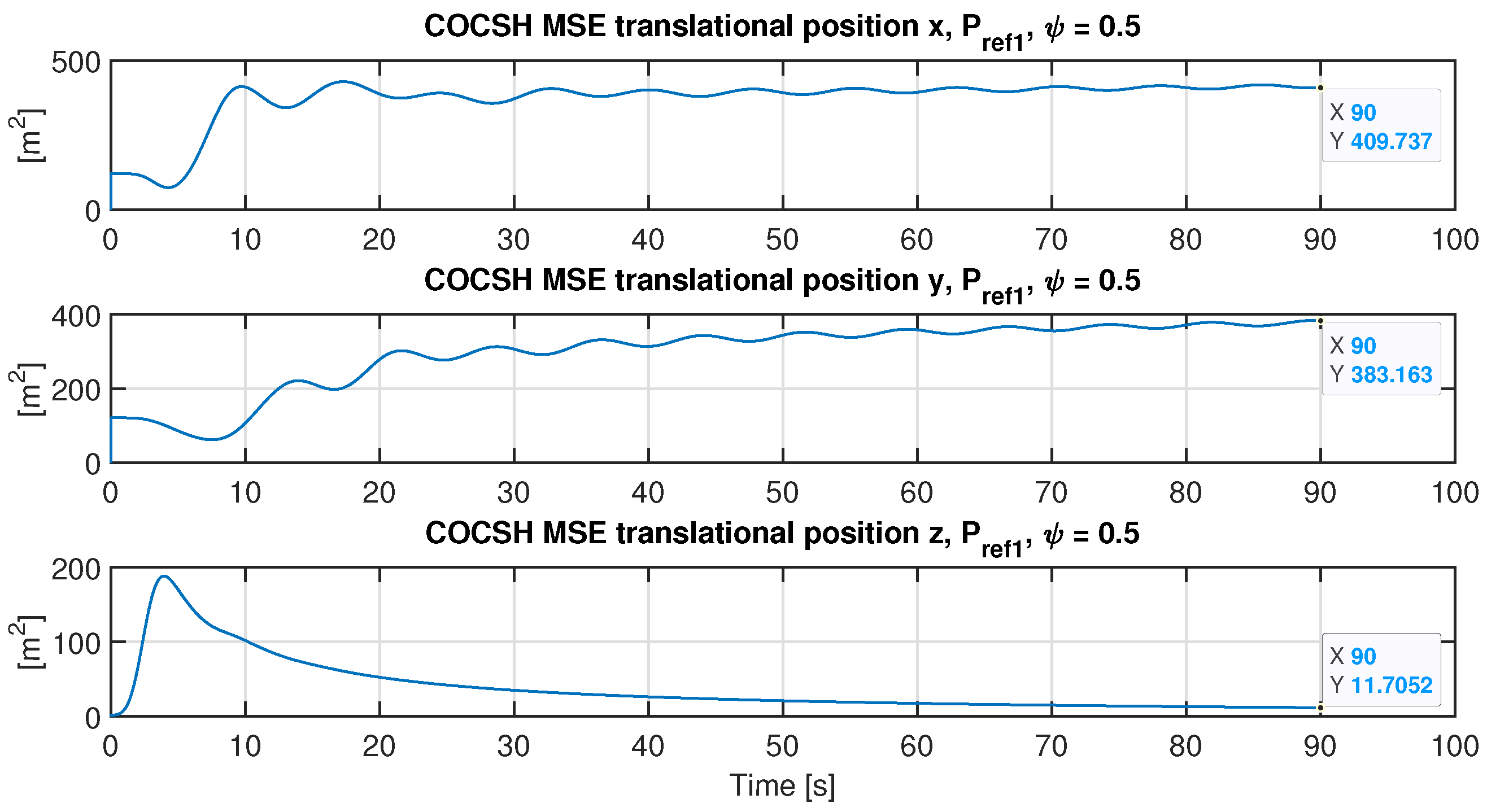
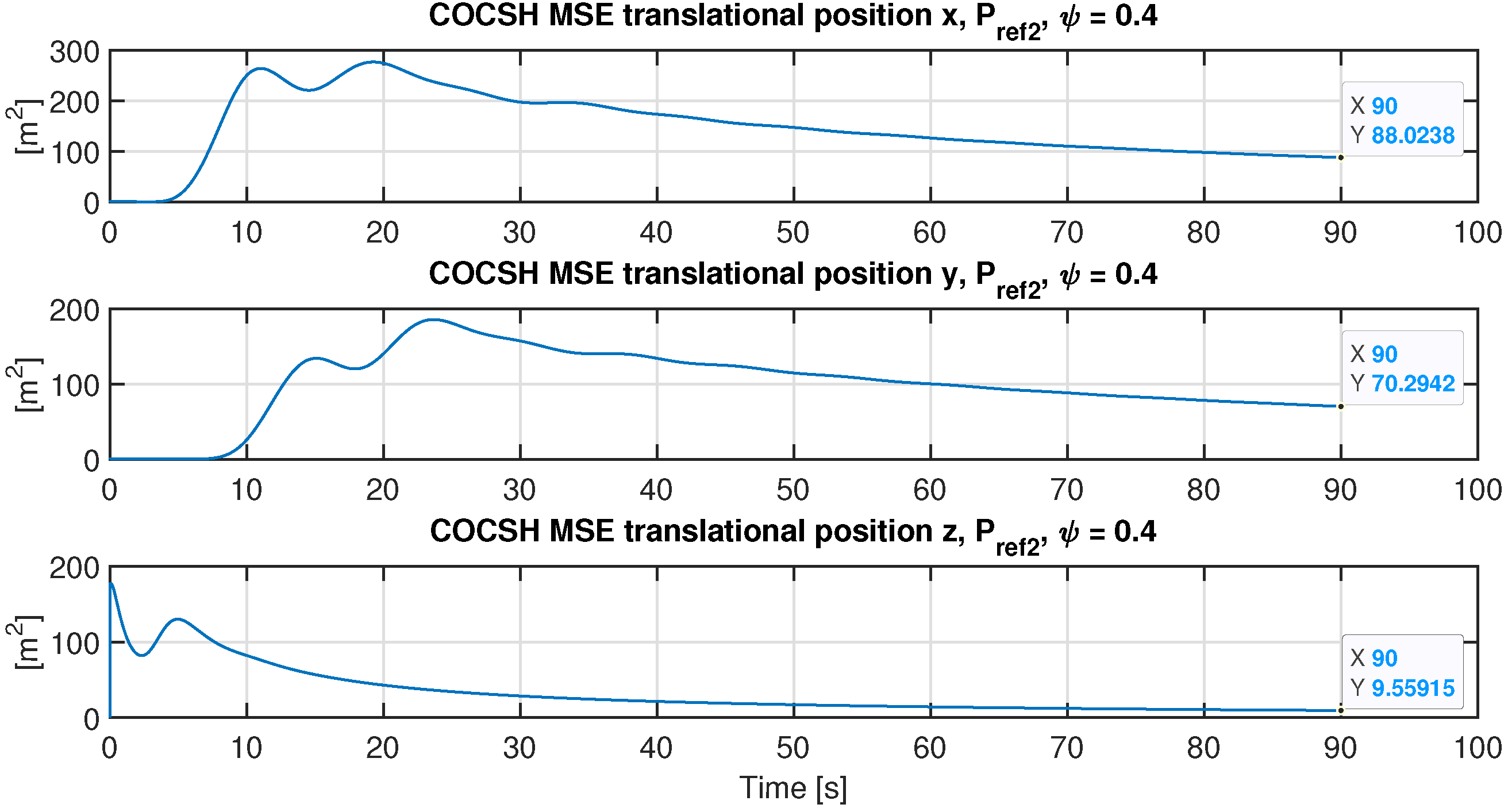
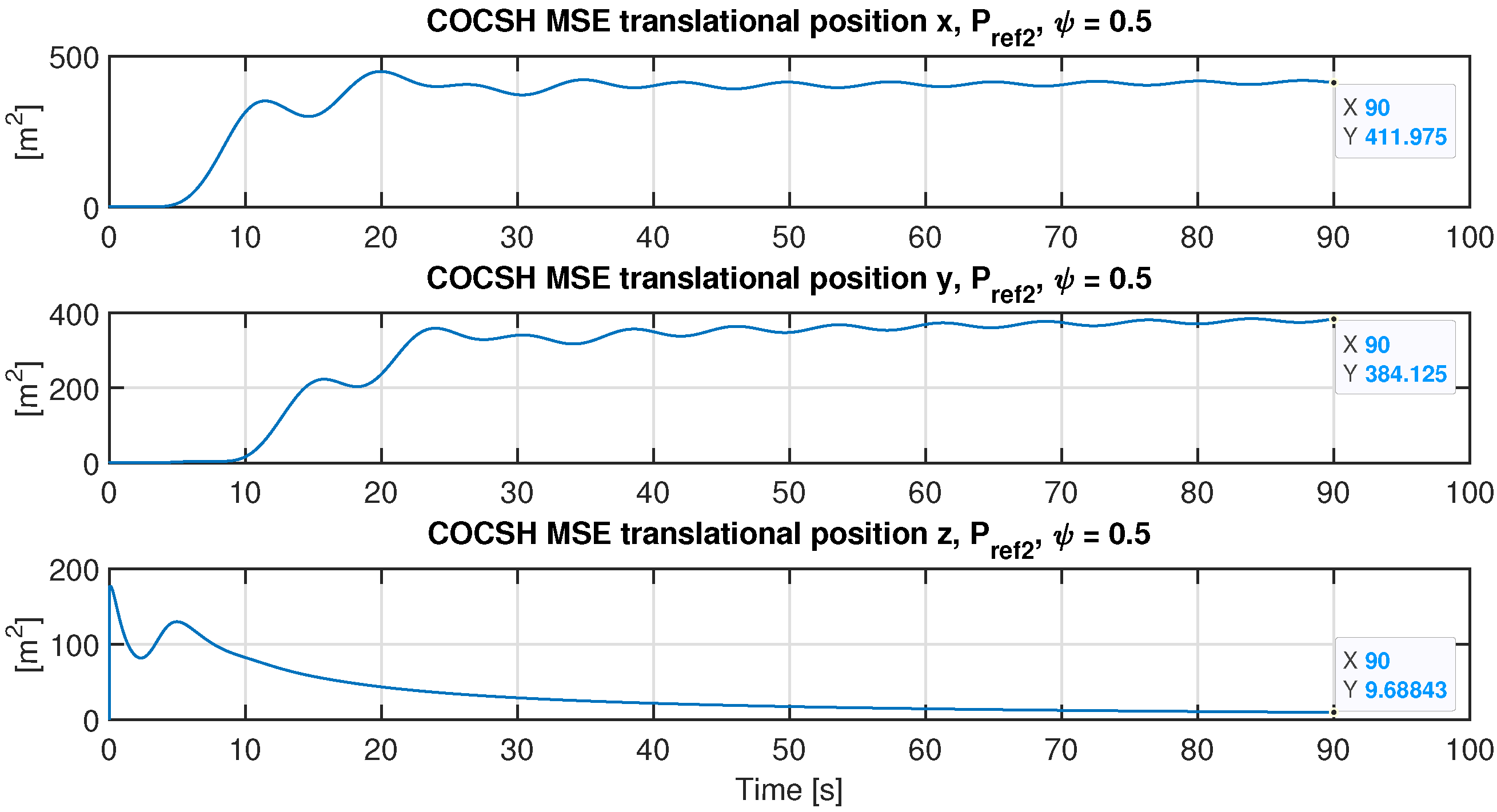




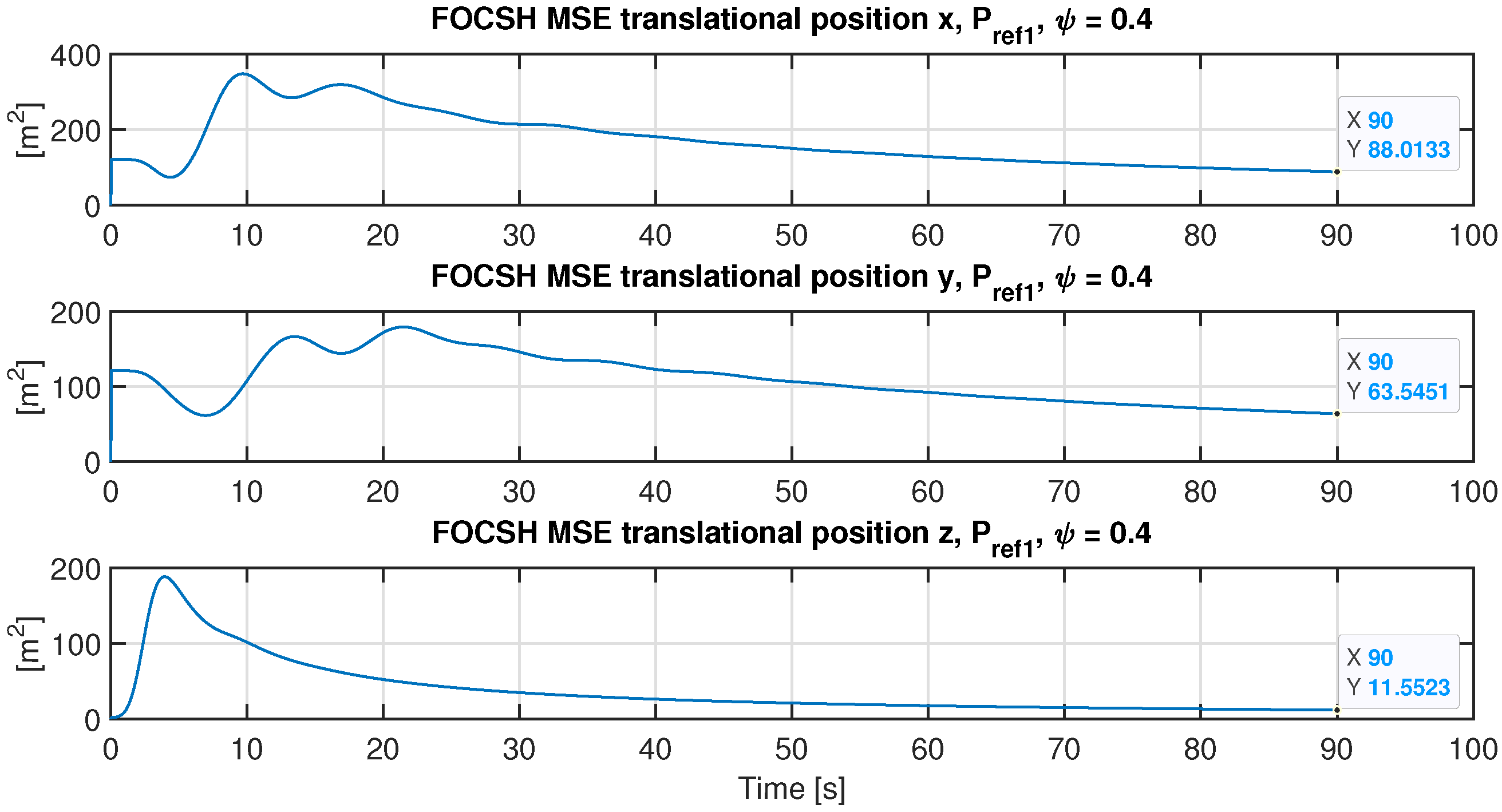
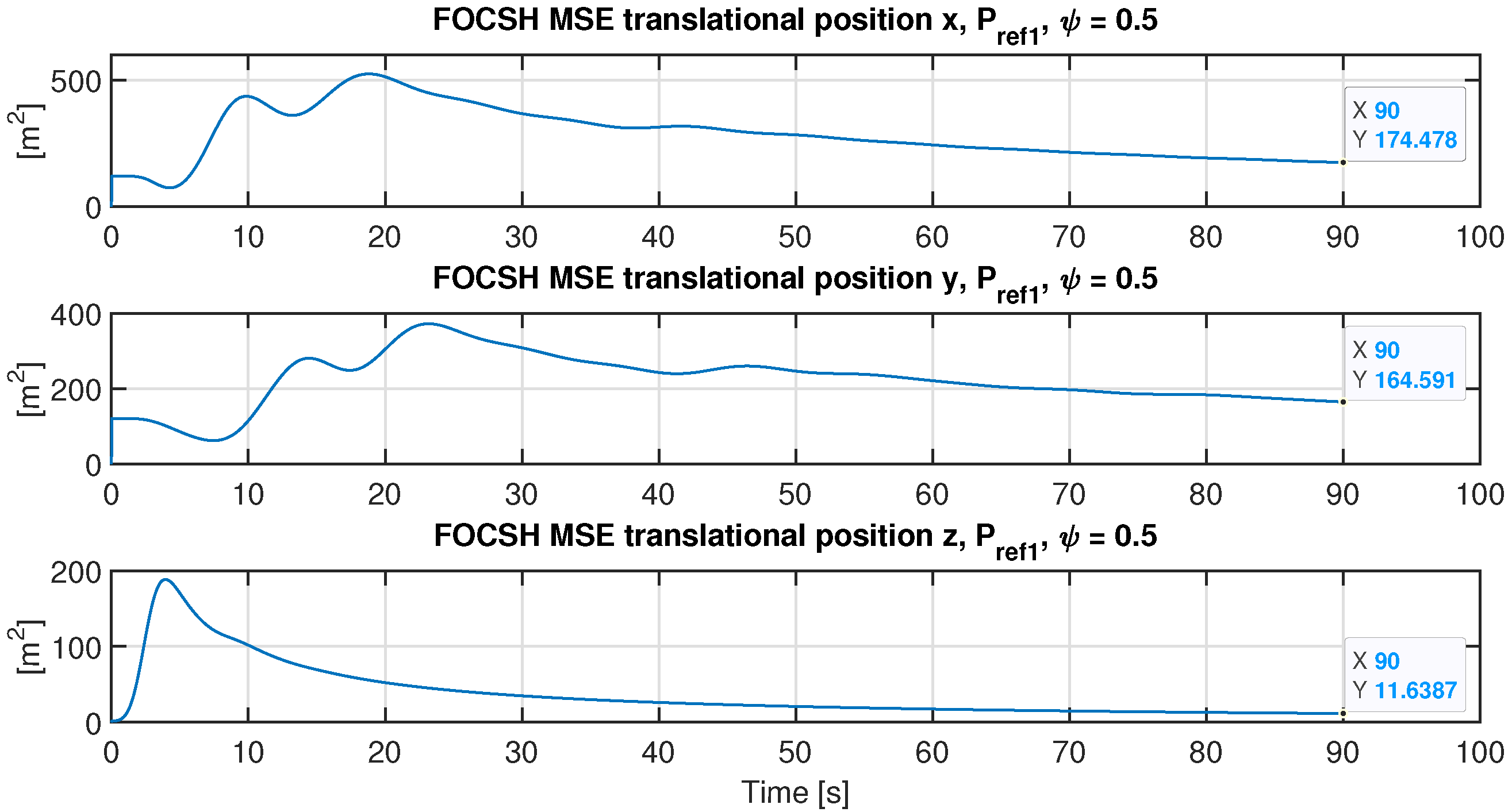

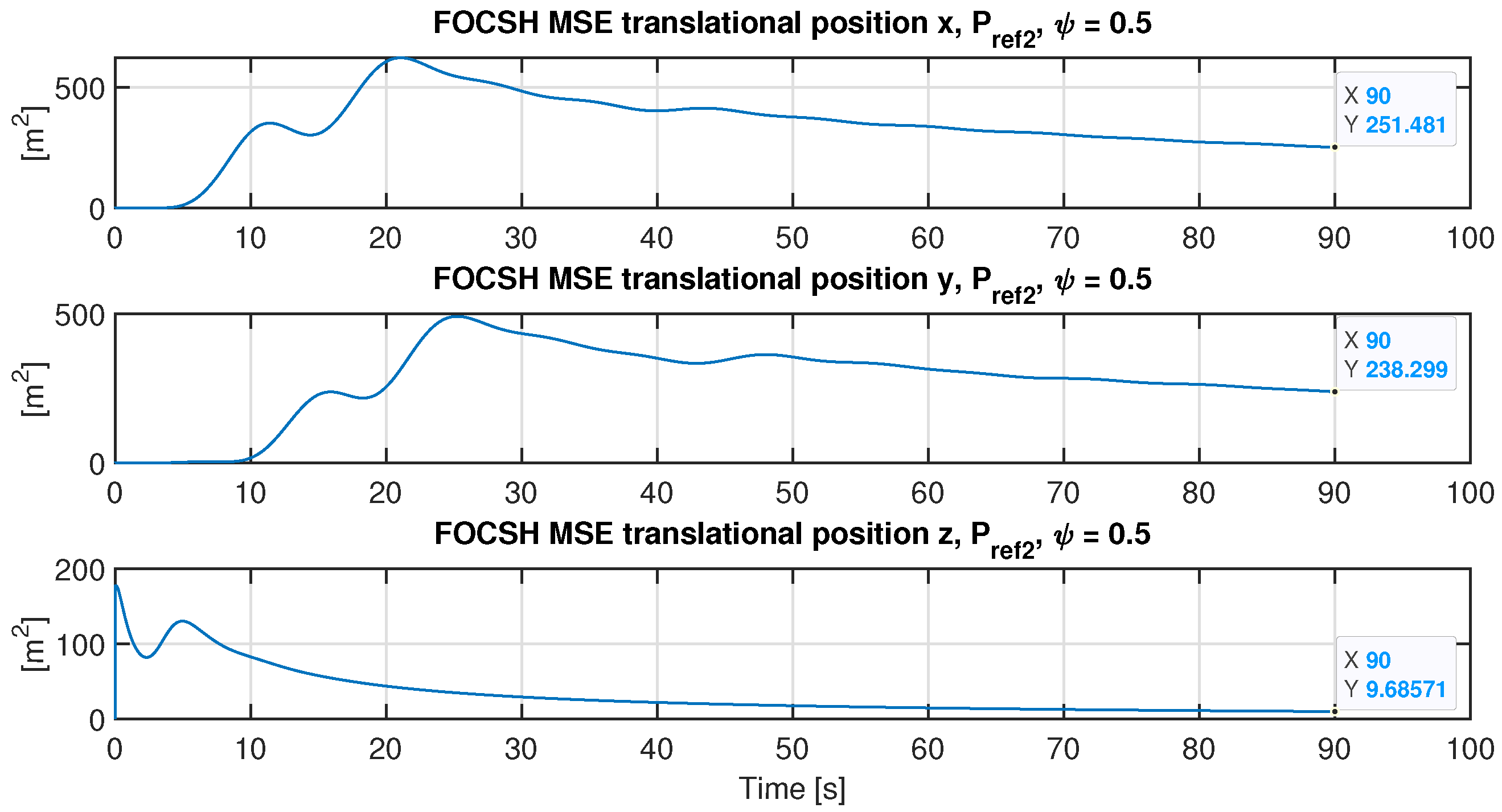
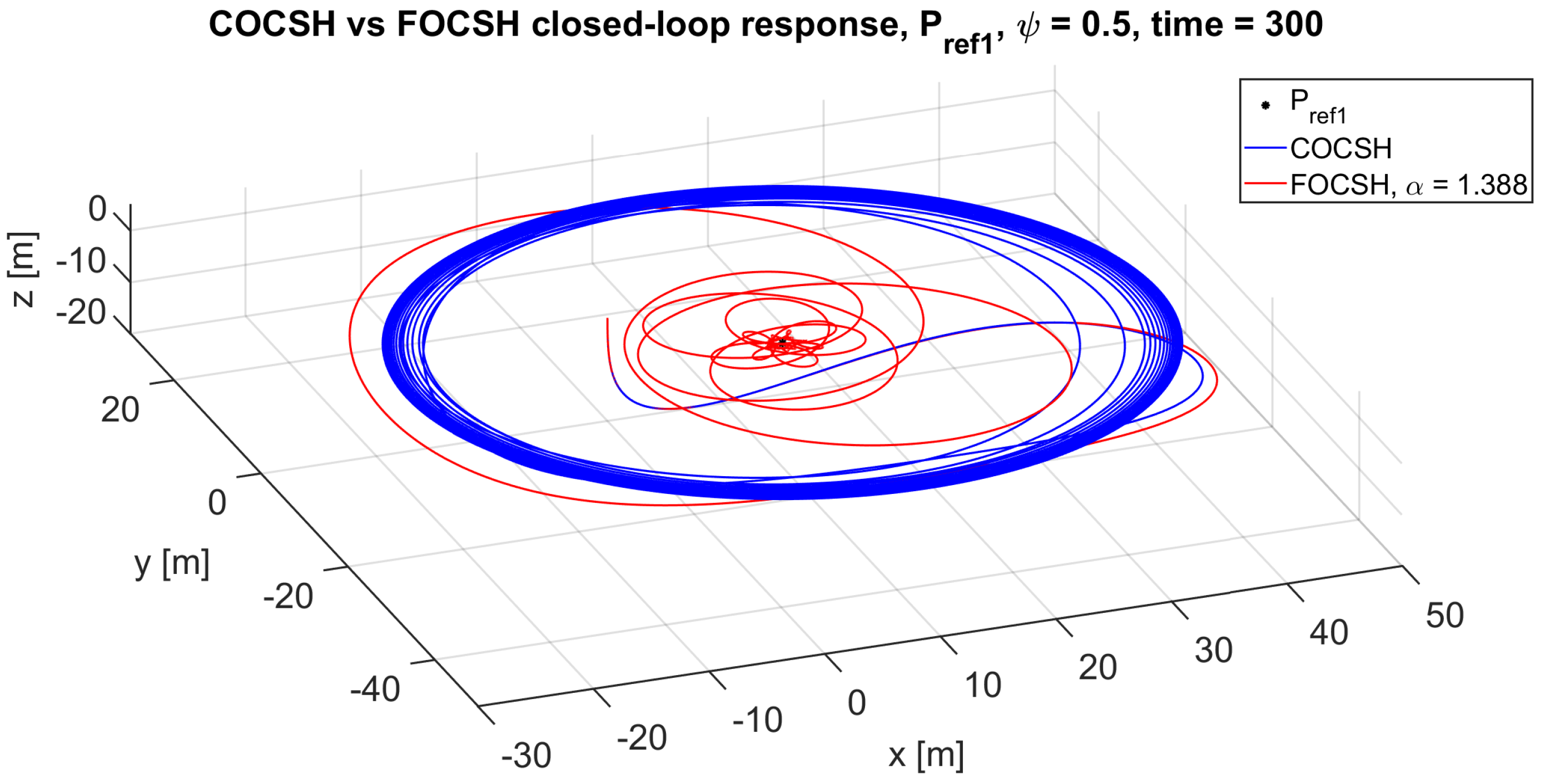

| State-Space Variables | State-Space Variables |
|---|---|
| Description | Parameter Value |
|---|---|
| UAV mass | kg |
| UAV rotor mass | 0.088 kg |
| UAV arm length | m |
| x axis inertia | |
| y axis inertia | |
| z axis inertia | |
| conversion constant to |
| MSE Translational Position | BQC-LR | |||
|---|---|---|---|---|
| Hover at Point | COCSH | FOCSH | COCSH | FOCSH |
| with : | ||||
| , | ||||
| , | ||||
| , | ||||
| with : | ||||
| , | * | |||
| , | * | |||
| , | * | |||
| with : | ||||
| , | ||||
| , | ||||
| , | ||||
| with : | ||||
| , | * | |||
| , | * | |||
| , | * | |||
| with : | ||||
| , | * | |||
| , | * | |||
| , | * | |||
| with : | ||||
| , | * | |||
| , | * | |||
| , | * | |||
| with : | ||||
| , | * | |||
| , | * | |||
| , | * | |||
| with : | ||||
| , | * | |||
| , | * | |||
| , | * | |||
Disclaimer/Publisher’s Note: The statements, opinions and data contained in all publications are solely those of the individual author(s) and contributor(s) and not of MDPI and/or the editor(s). MDPI and/or the editor(s) disclaim responsibility for any injury to people or property resulting from any ideas, methods, instructions or products referred to in the content. |
© 2024 by the authors. Licensee MDPI, Basel, Switzerland. This article is an open access article distributed under the terms and conditions of the Creative Commons Attribution (CC BY) license (https://creativecommons.org/licenses/by/4.0/).
Share and Cite
Delgado-Reyes, G.; Valdez-Martínez, J.S.; Guevara-López, P.; Hernández-Pérez, M.A. Hover Flight Improvement of a Quadrotor Unmanned Aerial Vehicle Using PID Controllers with an Integral Effect Based on the Riemann–Liouville Fractional-Order Operator: A Deterministic Approach. Fractal Fract. 2024, 8, 634. https://doi.org/10.3390/fractalfract8110634
Delgado-Reyes G, Valdez-Martínez JS, Guevara-López P, Hernández-Pérez MA. Hover Flight Improvement of a Quadrotor Unmanned Aerial Vehicle Using PID Controllers with an Integral Effect Based on the Riemann–Liouville Fractional-Order Operator: A Deterministic Approach. Fractal and Fractional. 2024; 8(11):634. https://doi.org/10.3390/fractalfract8110634
Chicago/Turabian StyleDelgado-Reyes, Gustavo, Jorge Salvador Valdez-Martínez, Pedro Guevara-López, and Miguel Angel Hernández-Pérez. 2024. "Hover Flight Improvement of a Quadrotor Unmanned Aerial Vehicle Using PID Controllers with an Integral Effect Based on the Riemann–Liouville Fractional-Order Operator: A Deterministic Approach" Fractal and Fractional 8, no. 11: 634. https://doi.org/10.3390/fractalfract8110634
APA StyleDelgado-Reyes, G., Valdez-Martínez, J. S., Guevara-López, P., & Hernández-Pérez, M. A. (2024). Hover Flight Improvement of a Quadrotor Unmanned Aerial Vehicle Using PID Controllers with an Integral Effect Based on the Riemann–Liouville Fractional-Order Operator: A Deterministic Approach. Fractal and Fractional, 8(11), 634. https://doi.org/10.3390/fractalfract8110634








